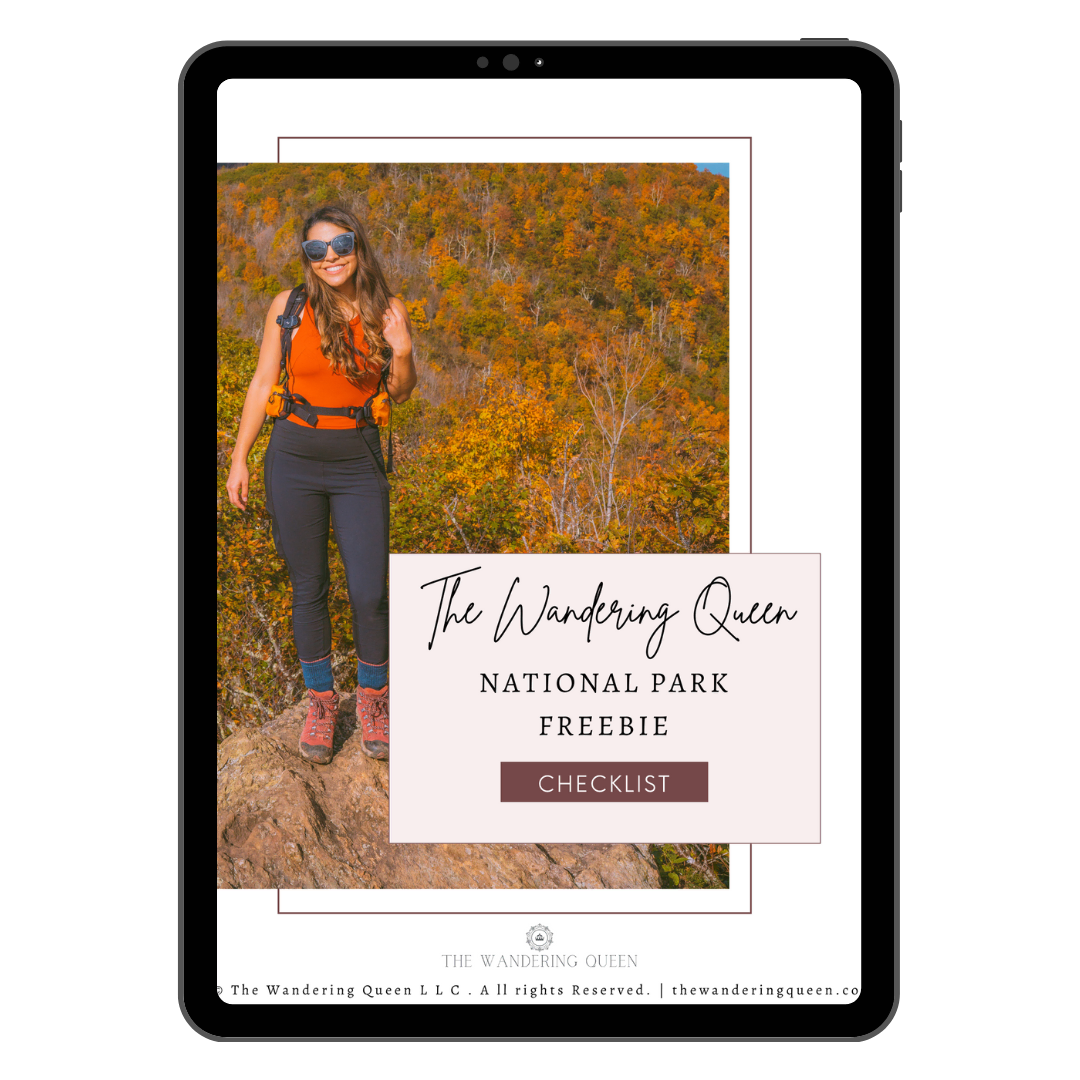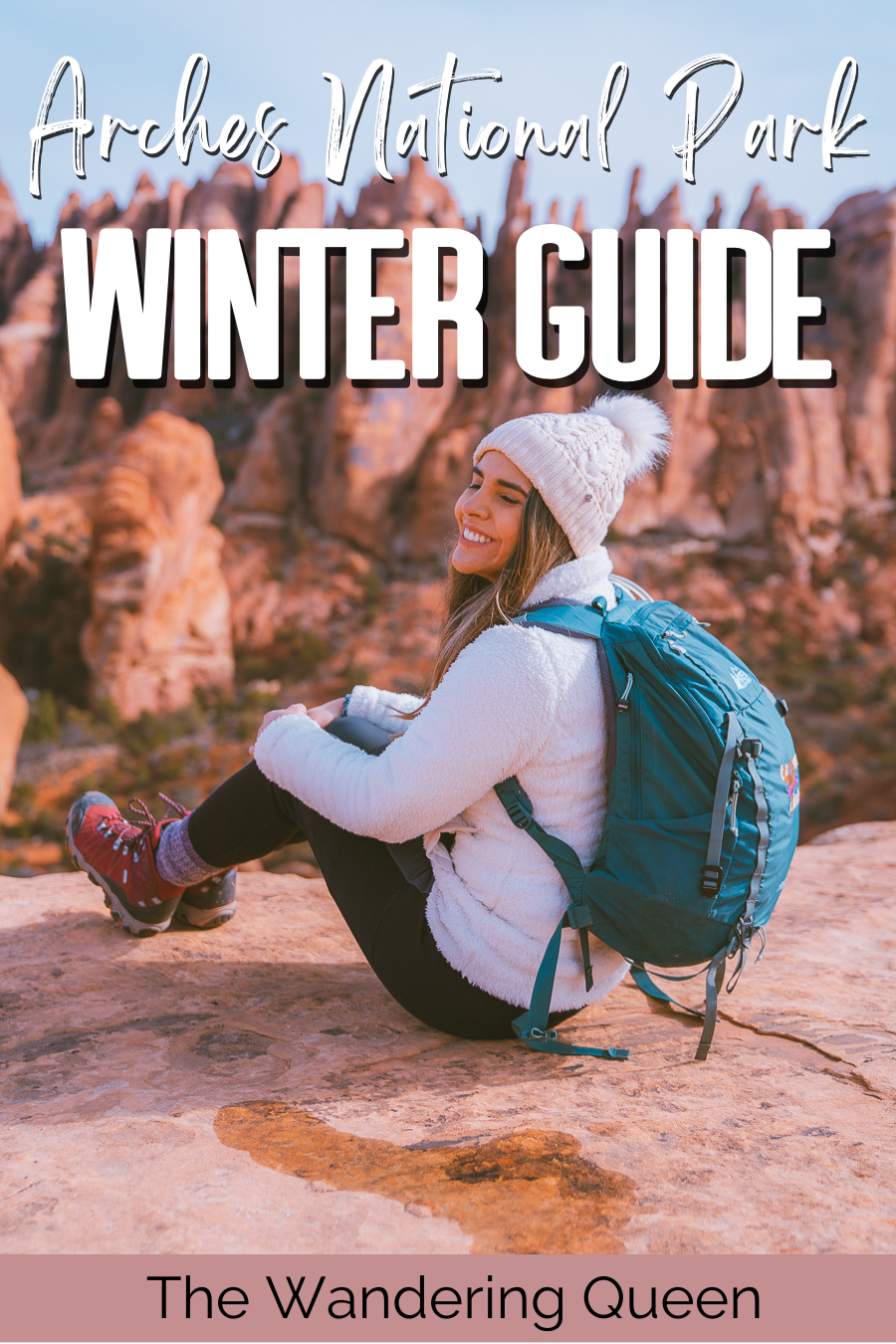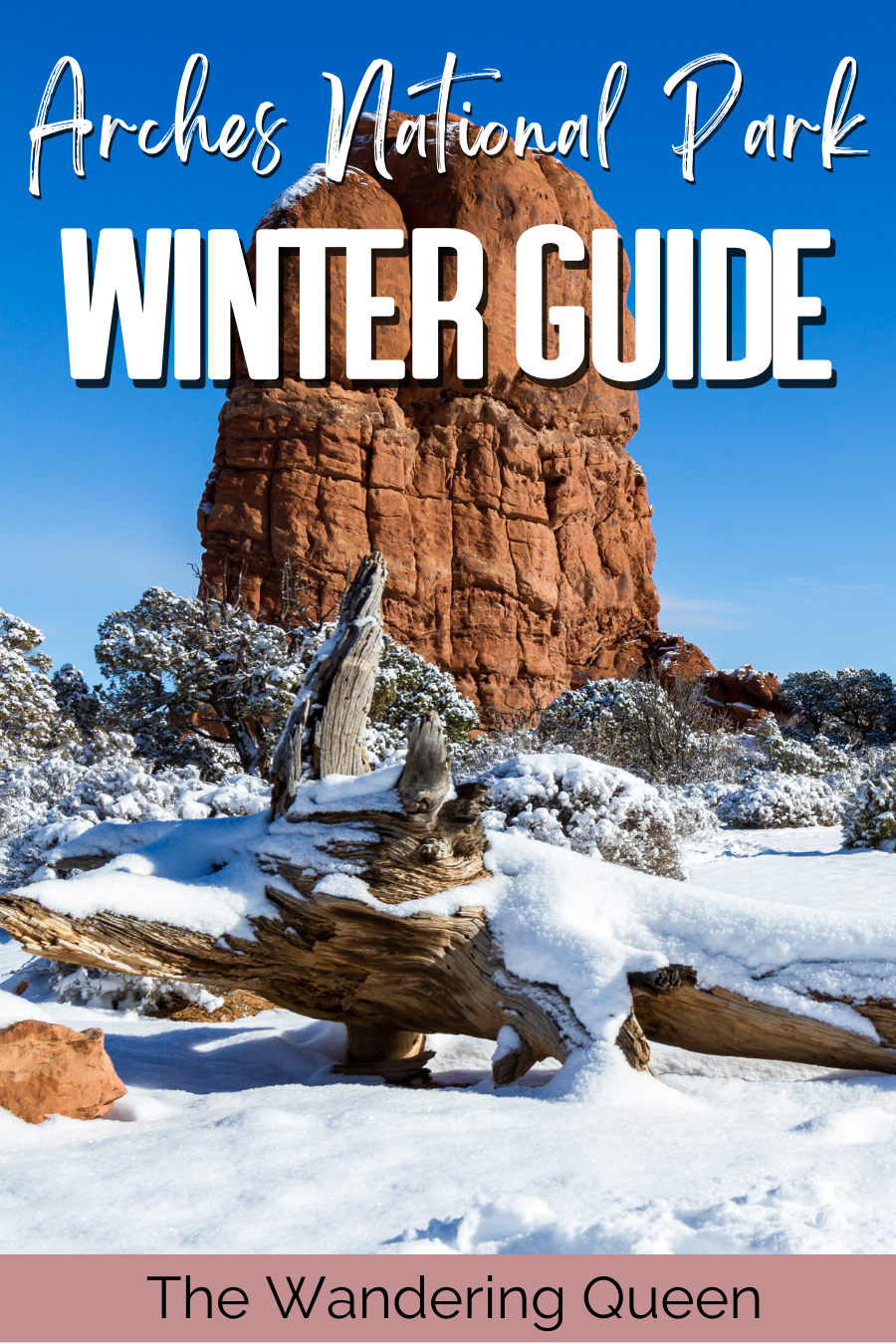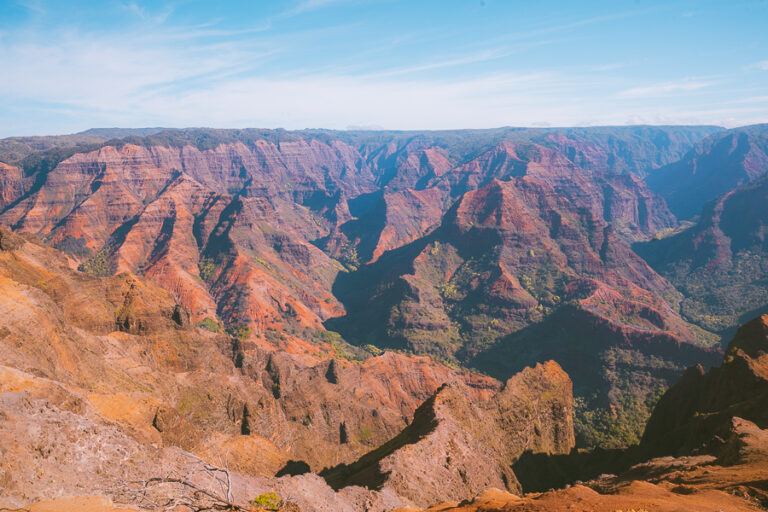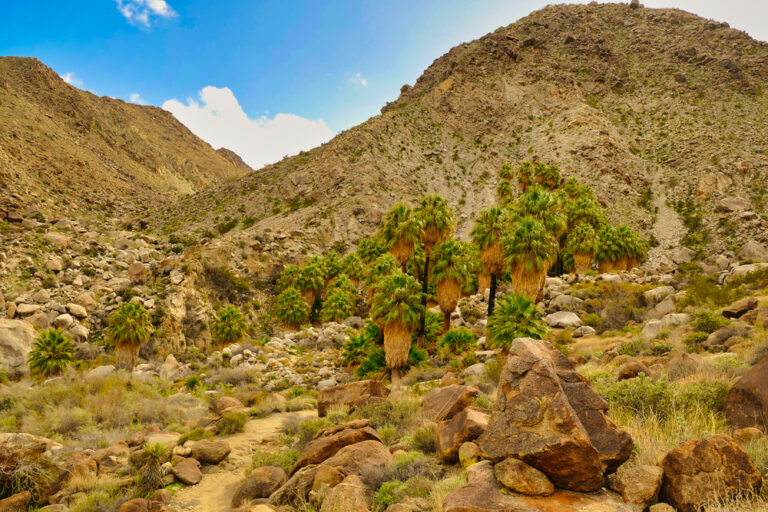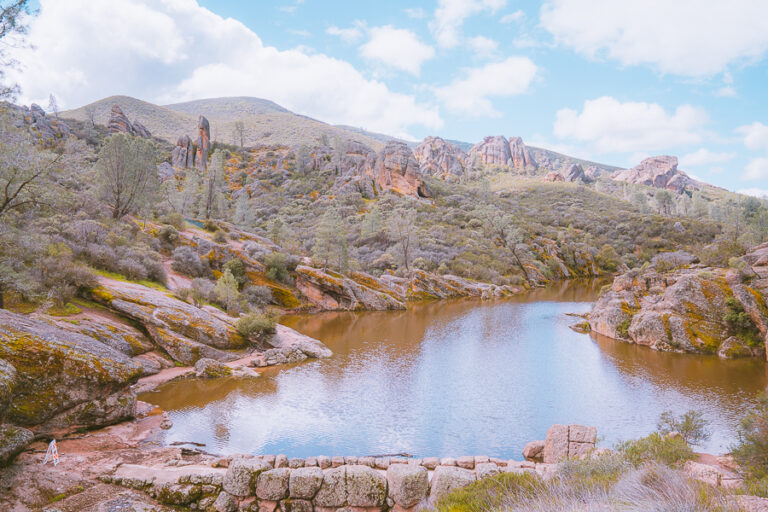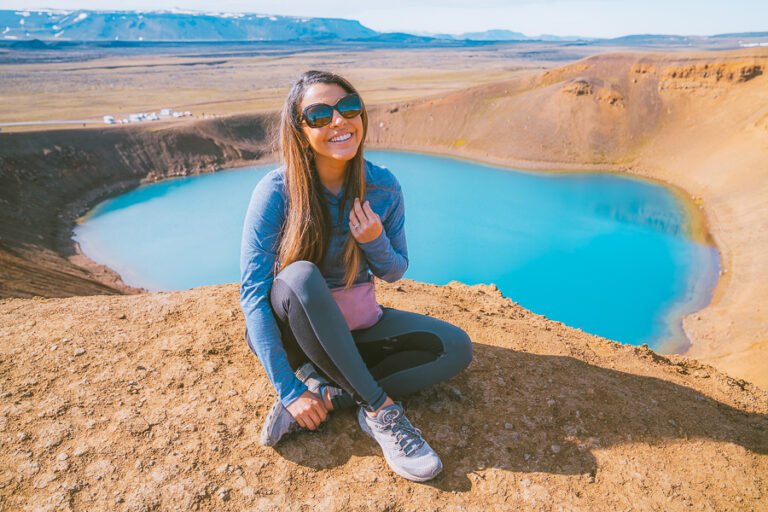Visiting Arches National Park in Winter | Snowy Weather Guide
If you’re looking for a snowy getaway, visiting Arches National Park in winter is an excellent option. Picture reddish-orange rock formations and the occasional desert shrub doused in a sprinkling of white snow. Dreamy, right?
It may sound daunting to visit any national park during the winter months. But, there are a surprising number of reasons to visit one of the best national parks in Utah during winter. And, with the right planning, you may just prefer visiting Arches during the colder months.
This guide covers everything you need to know about visiting Arches National Park in winter: from where to stay to the average temperatures and best activities. So grab your best winter hiking gear and clothes, and let’s jump right in.
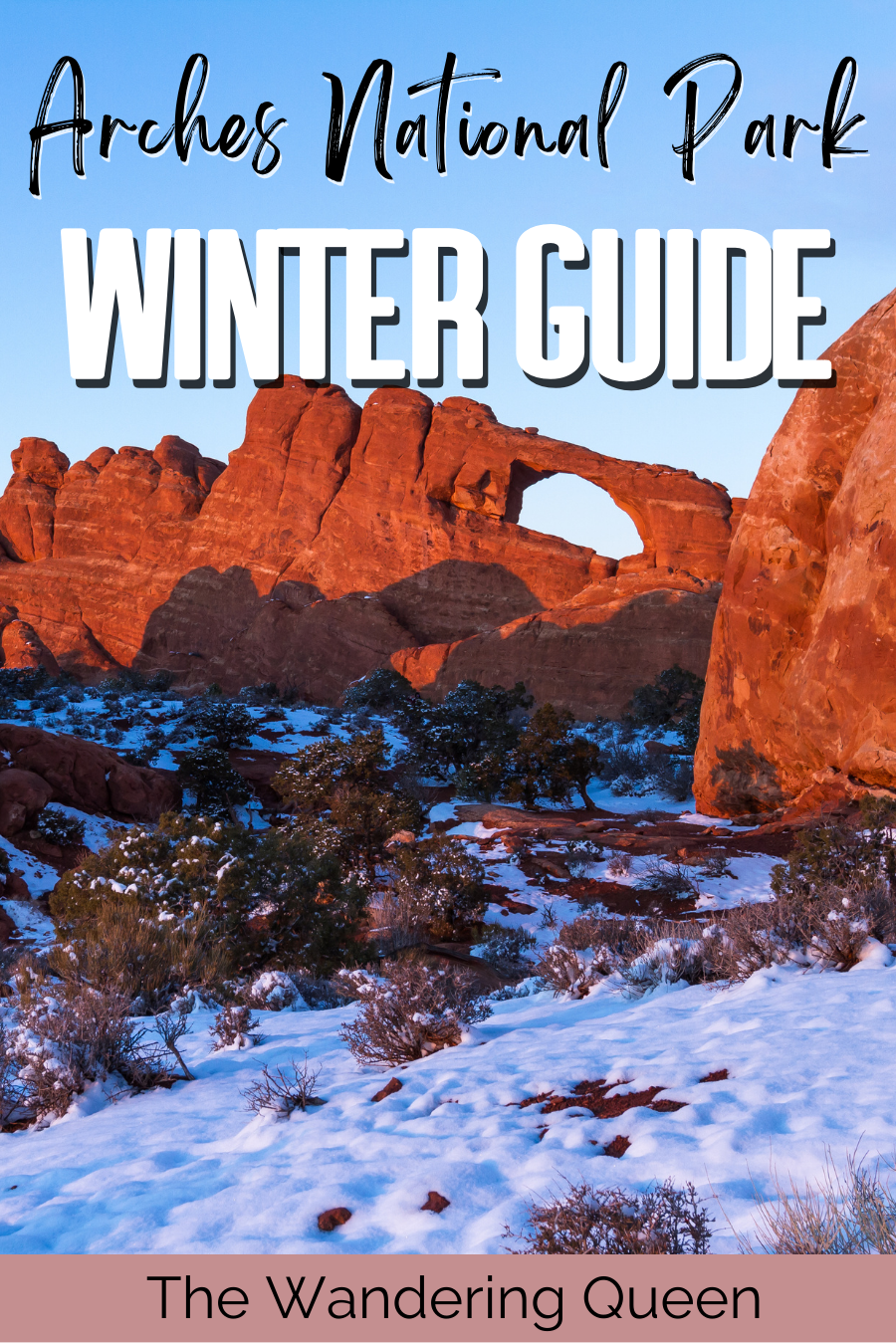
Disclosure: This post contains affiliate links. If you click one of them, I may receive a small commission (for which I am very grateful for) at no extra cost to you.
Arches National Park
Related Posts
Why You Should Visit Arches in Winter
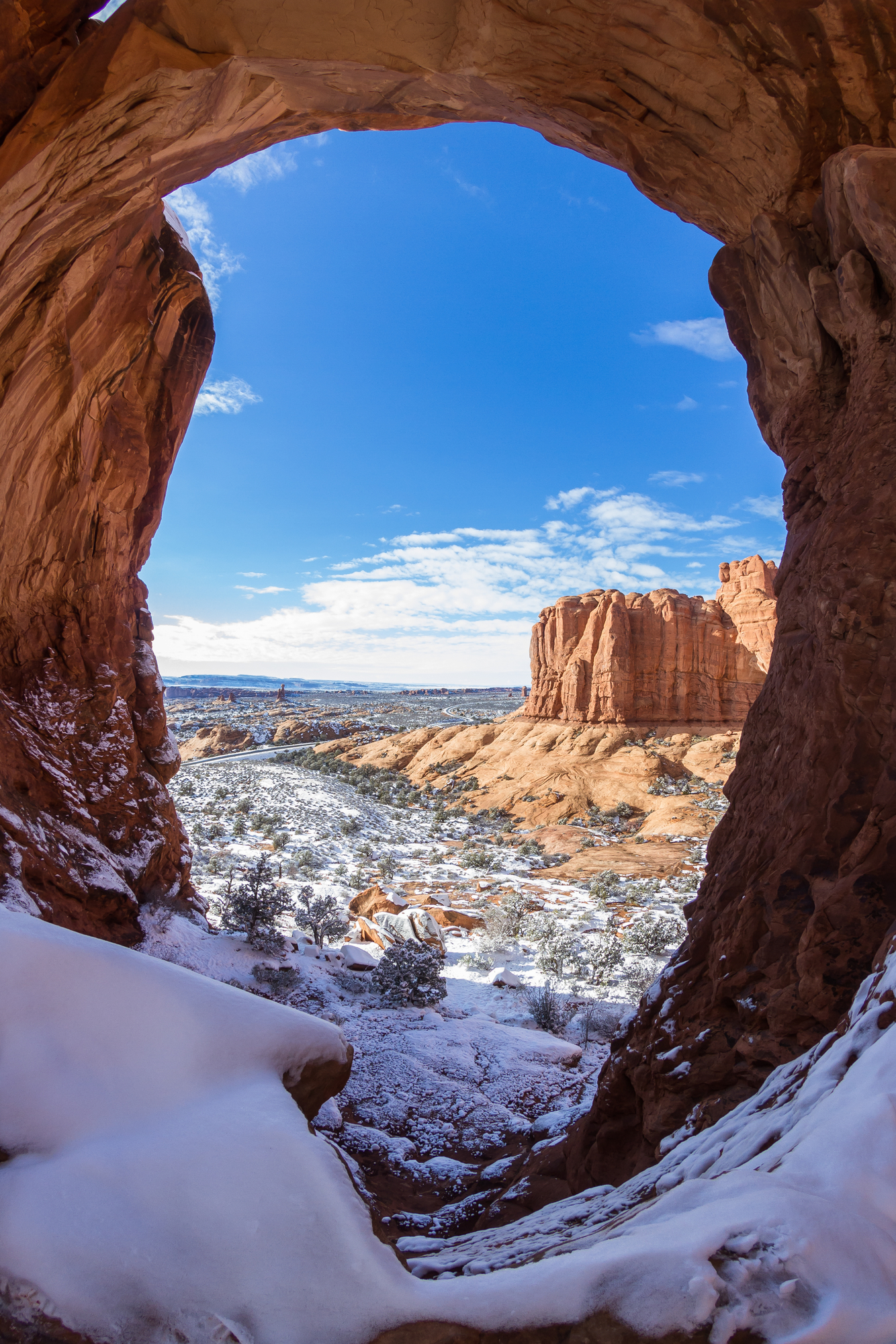
Cold weather may not sound like the ideal conditions for hiking or exploring, but there are plenty of reasons why you’ll love visiting Arches in winter. Of course, there are downsides like road or trail closures, but below are a few of the positives of visiting this national park in winter.
I have only been to Arches National Park in the winter (twice), and I have enjoyed it so much! I would definitely return again in the winter.
Avoid the Crowds
Firstly, and most importantly, you’ll be facing much fewer crowds. While the peak seasons of spring and summer see around 200,000 monthly visitors, winter only sees about 40,000 visitors per month.
With fewer people visiting Arches, you won’t have to worry about finding a parking spot or waiting in a long line to enter the park. You also won’t come across too many people along the trails — and might even have some trails all to yourself.
There is also a permit to enter most of the year except in the winter! So you do not need to worry about permits in the winter.
Photographic Opportunities
Above that, winter in Arches is a photogenic natural spectacle, meaning you can put your landscape photography skills to good use. You’re also much less likely to have your perfect frame of Delicate Arch photobombed by busy crowds.
Cheaper Accommodation
During the shoulder season, hotels and other accommodation options may also cut down their prices. And with fewer people filling up the nearby accommodations, you’ll get to secure that perfect room with a hot tub and splendid views.
Avoid Excessive Heat
The last point sort of goes without saying; a winter visit to Arches National Park means you won’t have to face hectic heat stroke or sunburn. During spring and summer, Arches National Park can become unbearably hot, often limiting your active times to the early morning and later afternoons.
But, during winter, you’ll have a much more refreshing time, and you can start your hike much later in the morning if needed. Of course, winter brings its own dangers, but we’ll cover that a bit later in the post.
Arches National Park Winter Weather & Temperatures
Below are the average minimum and maximum temperatures you can expect from the Arches winter weather when you visit.
- Arches National Park November Temperatures: 30°F / 56°F
- Arches National Park December Temperatures: 23°F / 45°F
- Temperatures in Arches National Park in January: 22°F/ 44°F
- Arches National Park February Temperatures: 28°F / 52°F
- Temperatures in Arches National Park in March: 35°F / 64°F
These average temperatures are merely a guide to help you pack the right clothing. Arches National Park is quite a desolate landscape. And, at an elevation of up to 5,653 feet, this arid landscape is prone to drastic and sudden temperature changes.
You can expect extreme lows going below 0°F and even highs reaching over 70 degrees in the winter months. So try to pack “just-in-case” clothing items and layers to accommodate various possible weather conditions.
Luckily, despite the park’s high altitude, Arches gets very little snowfall. So you won’t have to worry too much about heavy snow storms or trekking through a thick layer of snow. However, the snow and ice can still make roads and trails slippery and dangerous, so you’ll have to be extra cautious.
Read More: Best Time to Visit Arches National Park
Where to Stay in Arches National Park in the Winter
There are plenty of fun things to do in Moab and Arches, so you’ll want to spend a few days in the area. Below are a few of the top options in and around Moab for every budget.
Budget: Hyatt Place Moab
This budget-friendly accommodation in Moab features spacious, contemporary rooms and excellent views of the red, rocky cliffs surrounding it. You’ll have access to a fitness center to keep up with your workout goals or warm up before visiting Arches. This spot also offers a hot tub to unwind and warm up after a day of adventure and a coffee machine to help you fuel up for the day. >>>Check Availability
Mid-range: SpringHill Suites by Marriott Moab
The modern and elegant SpringHill Suites are one of the closest accommodations near the entrance to Arches National Park. You’ll wake up to views of red stone cliffs and get to soak away in the hot tubs.
These suites also feature well-equipped kitchens, so you can save some money by preparing your own meals. Other features like an on-site gym and a complimentary breakfast further add to the convenience of this spot. >>>Check Availability
Luxury: Downtown Inn Moab
This self-catering apartment in downtown Moab is conveniently located near plenty of shops and restaurants. The spacious, two-bedroom condo sleeps up to 10 people, making it the perfect option if you’re traveling as a group.
Whip up some hearty winter meals in the fully-equipped kitchen or watch your favorite series on the 60” TV. You’ll have access to air conditioning and a hot tub to keep you cozy. You’ll also get to prepare dinner under the stars with the patio and BBQ grill. >>>Check Availability
Camping: Sun Outdoors Arches Gateway
If you’re looking for a camping site with a bit more facilities than provided at Devils Garden Campground, this spot is a good choice. Situated along U.S. Highway 191 and near the Colorado River, this modern and manicured campsite is perfectly situated between the Arches entrance and Moab.
You’ll have access to electrical hookups, hot tubs to defrost your limbs, and charcoal grills. This site also offers entertainment in the form of mini-golf, life-size chess, and WiFi. >>>Find Out More
Tip: For more accommodation options, check out these excellent places to stay in Moab.
Things To Do in Arches in the Winter
So, what can and can’t you do in Arches National Park in winter? Let’s have a look.
Take the Arches Scenic Drive
If you’re absolutely freezing and not up for a hike, you can still see much of the park’s top attractions via the Arches Scenic Drive. This 19-mile paved road through the park leads past many trailheads and sights like Balanced Rock and Double Arch and ends at the Devils Garden Trailhead.
Roads may be icy and slippery, so drive with caution and check the weather conditions before taking a drive. If it does snow, much of the ice will have melted or been plowed away by midday, but it’s always better to check in at the Visitor Center for advice.

Tip: Try this self-guided driving tour to learn more about the park’s top sights during your scenic ride.
Devils Garden Trail and Landscape Arch
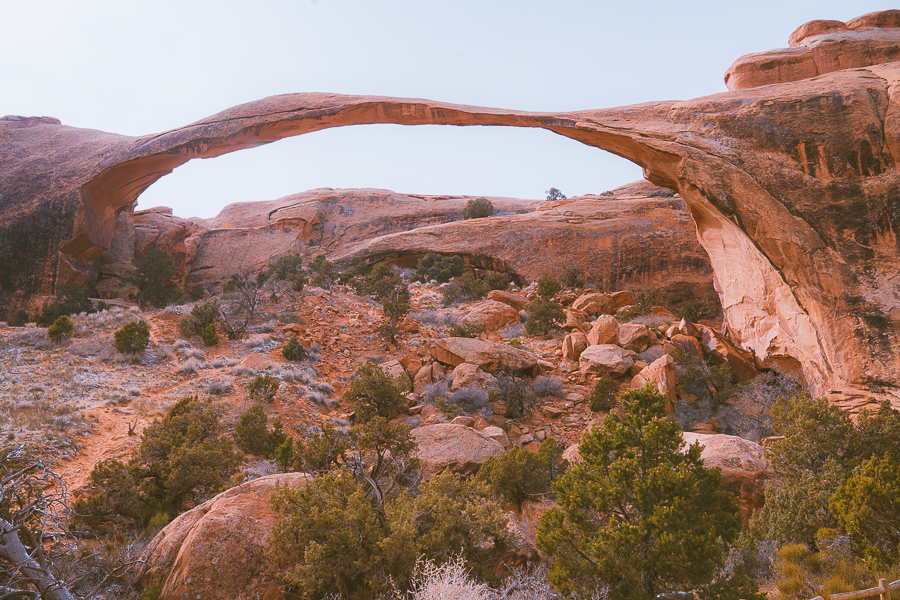
Home to seven natural arches, the Devils Garden Trail is one of my all-time favorite hikes, as it’s great for all fitness levels. The easiest portion of the hike is a 1.9-mile round-trip that leads past Pine Tree Arch and Tunnel Arch to Landscape Arch.
The first two arches are less impressive than Landscape Arch. So if you want to shorten your trail even more, you can cut those two out of the hike. Landscape Arch is the longest natural arch in the U.S. Spanning a whopping 306 feet, it seems almost impossible that this large stretch of rock is still standing.
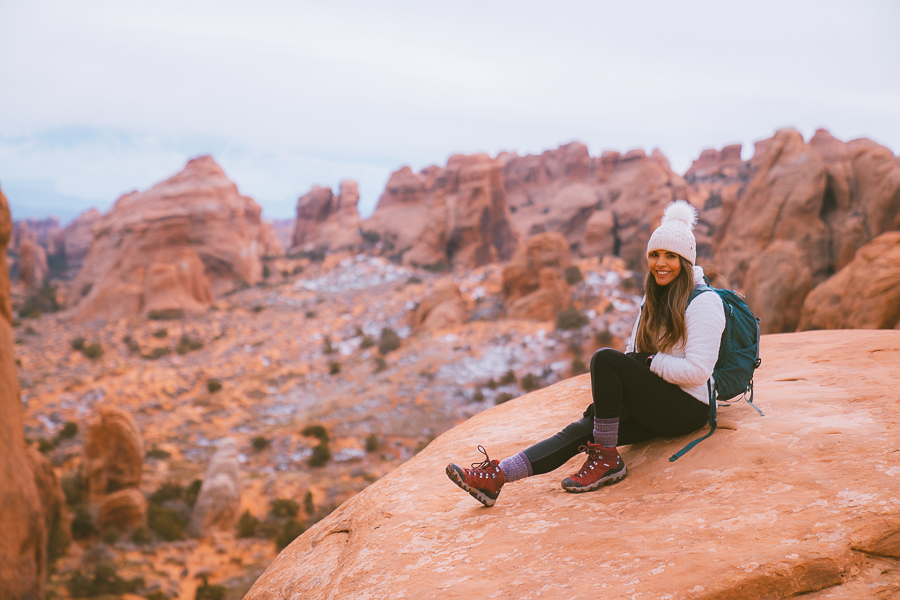
If the hike to Landscape Arch isn’t challenging enough, you can usually continue your hike to four more arches; Partition, Navajo, Double-O, and Private Arch. However, the trail gets much trickier beyond Landscape Arch and can be extra challenging to hike when it’s icy.
So it’s not advised to hike the entire Devils Garden Loop when there is a lot of ice or snow. If you do, be sure to wear your best winter hiking boots and only go further if you’re confident in your hiking and navigational skills.
Go Stargazing
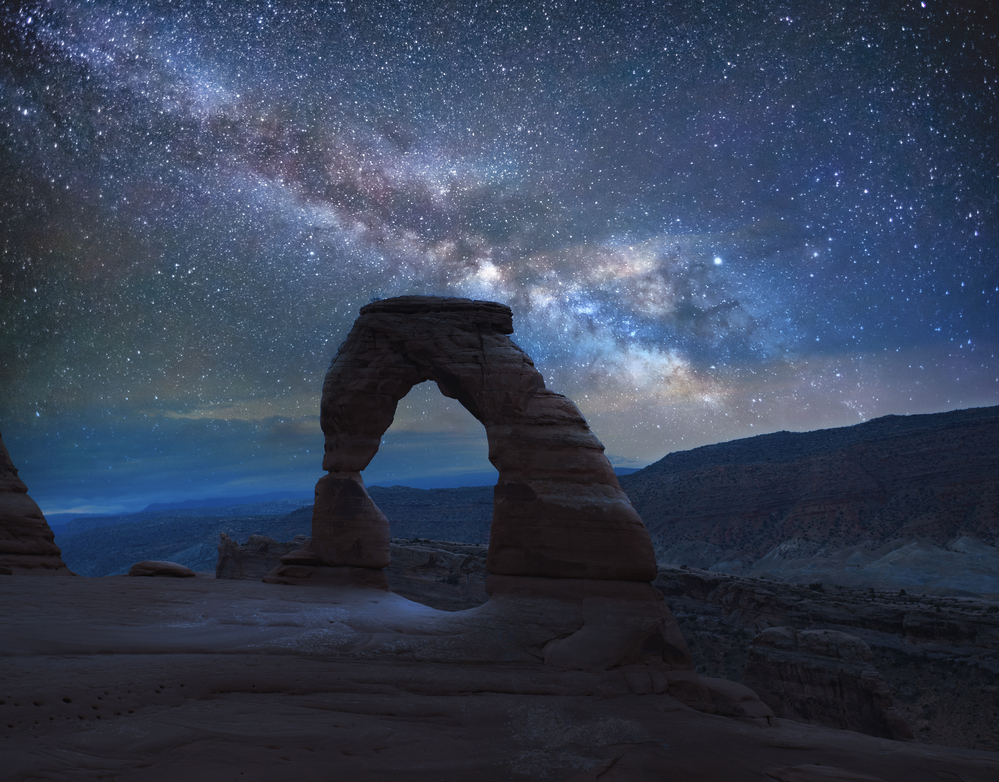
The winter days may be shorter, but that means you’ll have more nighttime hours to gaze up at the starry skies. This International Dark Sky-certified park is one of the darkest places in the world, so it’s perfect for spotting constellations and admiring shooting stars. It’s also a great time to bring out the camera and snap some memorable shots.
There are various places from which you can admire the night sky, but here are some of the top areas:
- Balanced Rock
- Panorama Point
- The Windows Section
- Garden of Eden Viewpoint
- Devils Garden Area
- Delicate Arch
The sky is most visible during the new moon, and the further away you are from Moab’s lights. Use a red headlight or flashlight to move around the park without interfering with your views of the stars.
Camping at Devils Garden Campground
Devils Garden Campground is the only campground in Arches National Park. During the peak tourist season between March and October, Devils Garden Campground’s 51 sites are pre-booked and packed, and it can be challenging to find an open campsite.
But, between November and February, the campground operates on a first-come, first-served basis. So you’ll have a much better chance of booking one of the 25 available sites during winter.
The campground sits 18 miles from the park entrance, near the end of Arches Scenic Drive. Camping fees are around $25 per camping site, limited to 10 people and two vehicles. You’ll have access to limited facilities. These include toilets, picnic tables, potable water, and grills.

Tip: Temperatures can become freezing in Arches National Park at night, so come prepared with your best camping gear and warmest sleeping bags.
Take the Park Avenue Trail
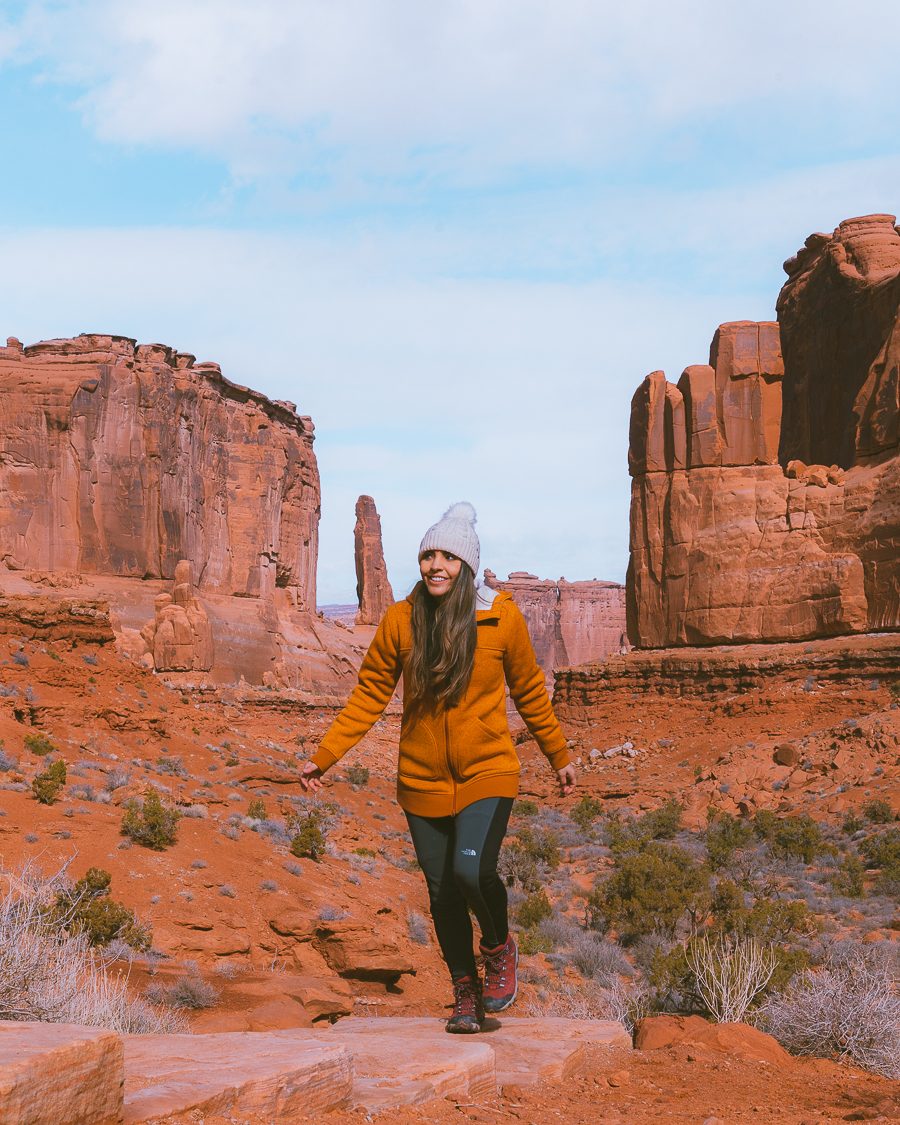
This short and relatively easy 2-mile out-and-back hike through a canyon is nothing short of breathtaking, despite it not having any arches along the way. Instead, you’ll come across imposing structures that tower over the trail. Two notable ones are the Three Gossips and the Courthouse Towers.
You can shorten this trek by only hiking one way and getting someone to pick you up on the other end of the trail. Or, you can simply admire the canyon from the Park Avenue Viewpoint, which is about 320 feet from the Park Avenue car park. It is one of the first trails you’ll come across in the park and is great as a warm-up before taking on other hikes.
Photograph The Windows & Turret Arch
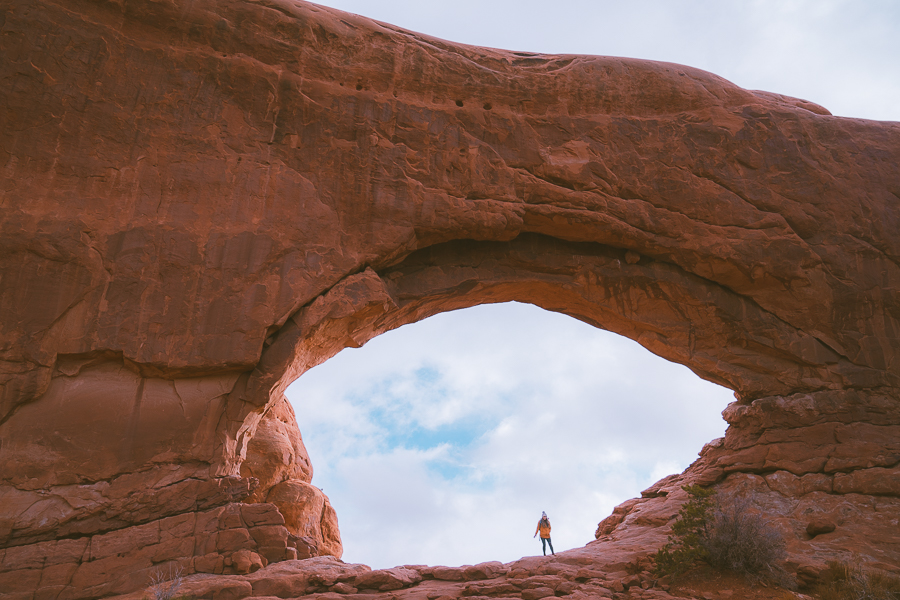
The Windows section is one of the most popular attractions in Arches National Park. It’s easily accessed via a 1.2-mile round-trip trail that starts at a car park on Windows Road. You’ll come across the North and South Windows, which look like a pair of spectacles, as well as the Turret Arch.
You’ll want to bring your best camera gear along for this easy hike. Try framing Turret Arch through one of The Windows, or simply get a photo of you standing below one of the arches. If you do attempt to stand below the arches, be weary of icy and slippery rocks.
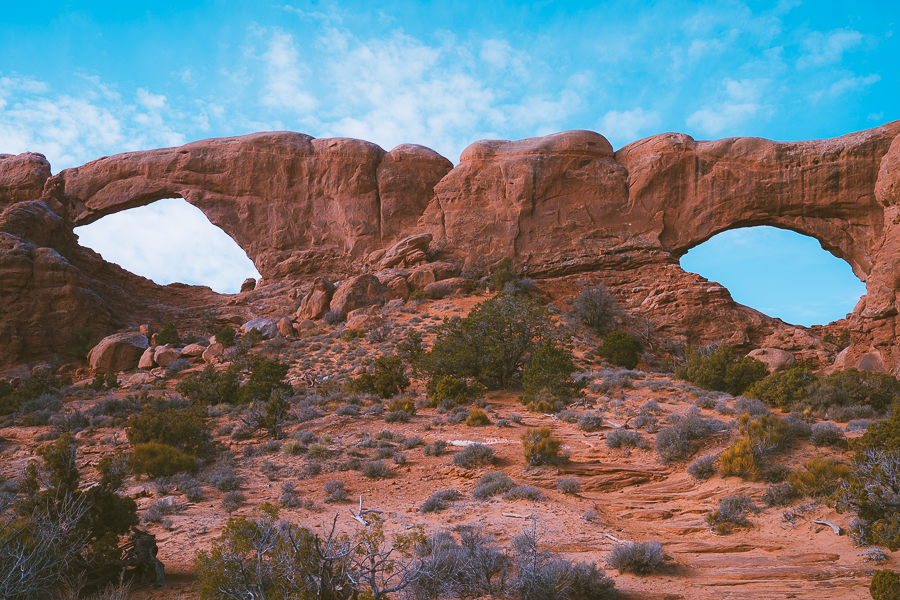
This hike is pretty easy, but you can make it more challenging by returning to the trailhead via the 0.7-mile primitive trail. This trail is marked with cairns, which may be hidden under ice, and you’ll have to scramble and climb over a few (possibly slippery) rocks. So only attempt this trail if you’re familiar with it or confident in your navigational skills.
Download my free Outdoor Photography Guide
Hike to Delicate Arch
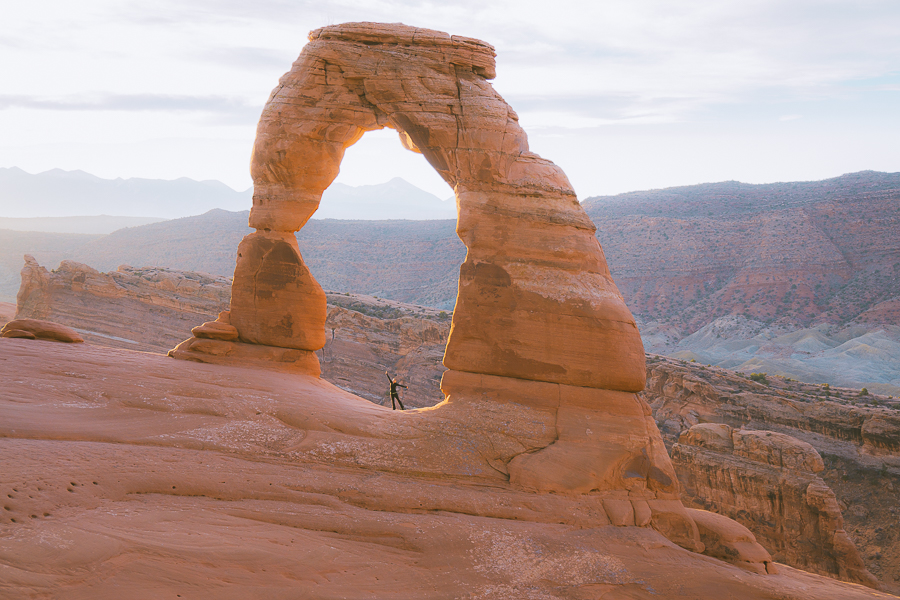
Delicate Arch is basically the poster child of Arches National Park, and with good reason. With a 46-foot-high, 32-foot-wide light opening, Delicate Arch is the largest free-standing arch in the park. It’s hard to comprehend its majesty without standing beneath it, as it appears quite small with the La Sal Mountains in the background.
Because of its size and beautiful backdrop, the 3-mile round-trip Delicate Arch trail is one of the best hikes in Arches. It is also one of the most popular and crowded trails during peak season. Luckily, the trail is much quieter during winter — and you won’t have to wait in a long line to capture the arch.
Read Next: 13 Best National Parks to Visit in January
But, the Delicate Arch hike is not for the faint of heart, especially not when the trail is icy.
Most of the moderate hike up is relatively safe. But there’s a steep drop-off near the end of the hike that may get your heart racing. Wear secure boots with ice grips and make use of hiking poles where possible.

Tip: While the park certainly sees fewer visitors during winter, Delicate Arch remains one of the top attractions. So the parking lot at the Delicate Arch trailhead may get full by midday.
Go to The Upper and Lower Delicate Arch Viewpoints
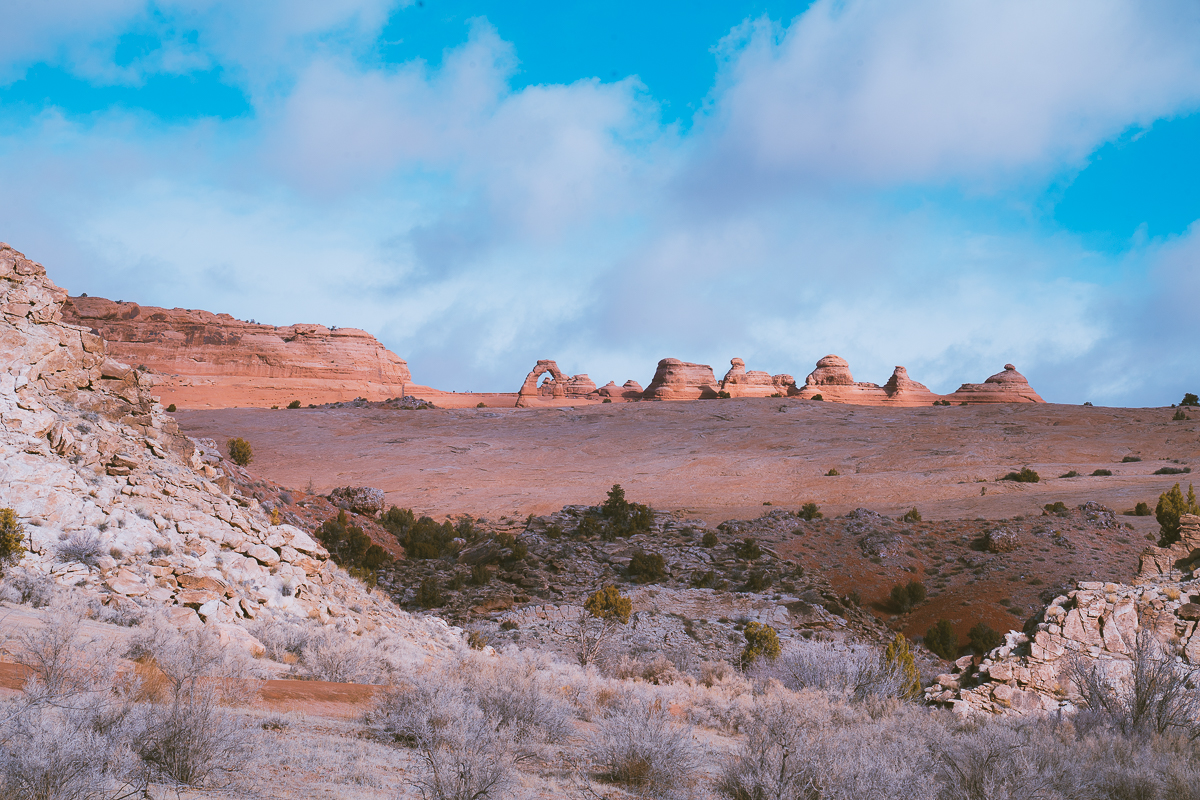
If you’re not up for the somewhat scary (yet doable) hike to Delicate Arch, you can admire the arch from a viewpoint instead. The Lower Delicate Arch Viewpoint is near the parking lot, while The Upper Viewpoint is accessed via a short 0.5-mile uphill trek. The latter viewpoint provides a better view of the arch.
Tackle the Sand Dune & Broken Arch Hike
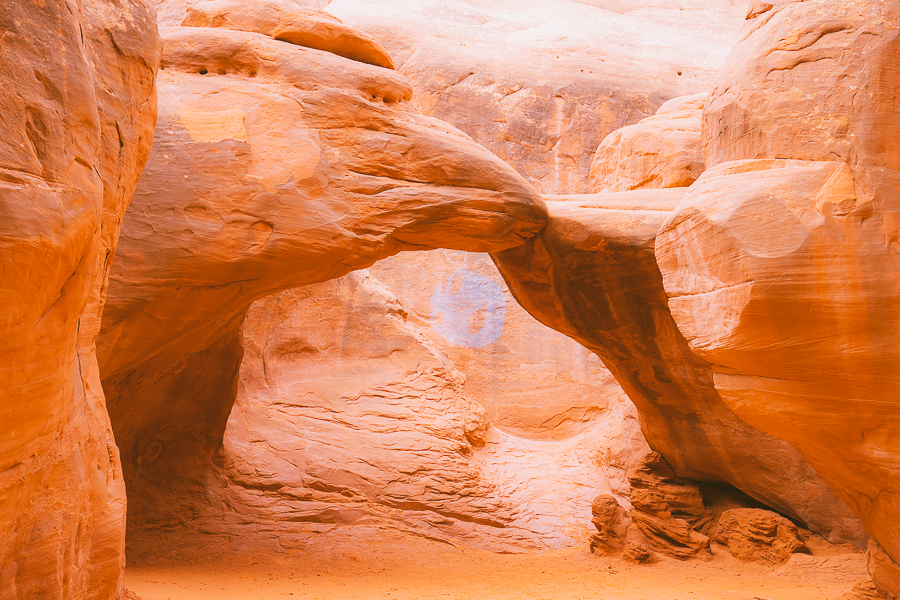
The 0.4-mile round-trip to Sand Dune Arch is the perfect mini-hike on hot days. But it’s equally lovely to visit in winter if you’re not keen on spending too much time in the cold.
Sand Dune Arch is a little tucked-away gem snuggled among large sandstone fins. Parts of the red, sandy trail may even be frozen during your hike, which makes for a spectacular photo op.
You can extend this hike to the (very much not) Broken Arch, which sits along a 1.8-mile loop that also kicks off at the same trailhead. This extended loop will take about 1.5 hours, while the short hike to Sand Dune Arch will only take about half an hour.
Read More: Best Hikes In Arches National Park
Admire Balanced Rock
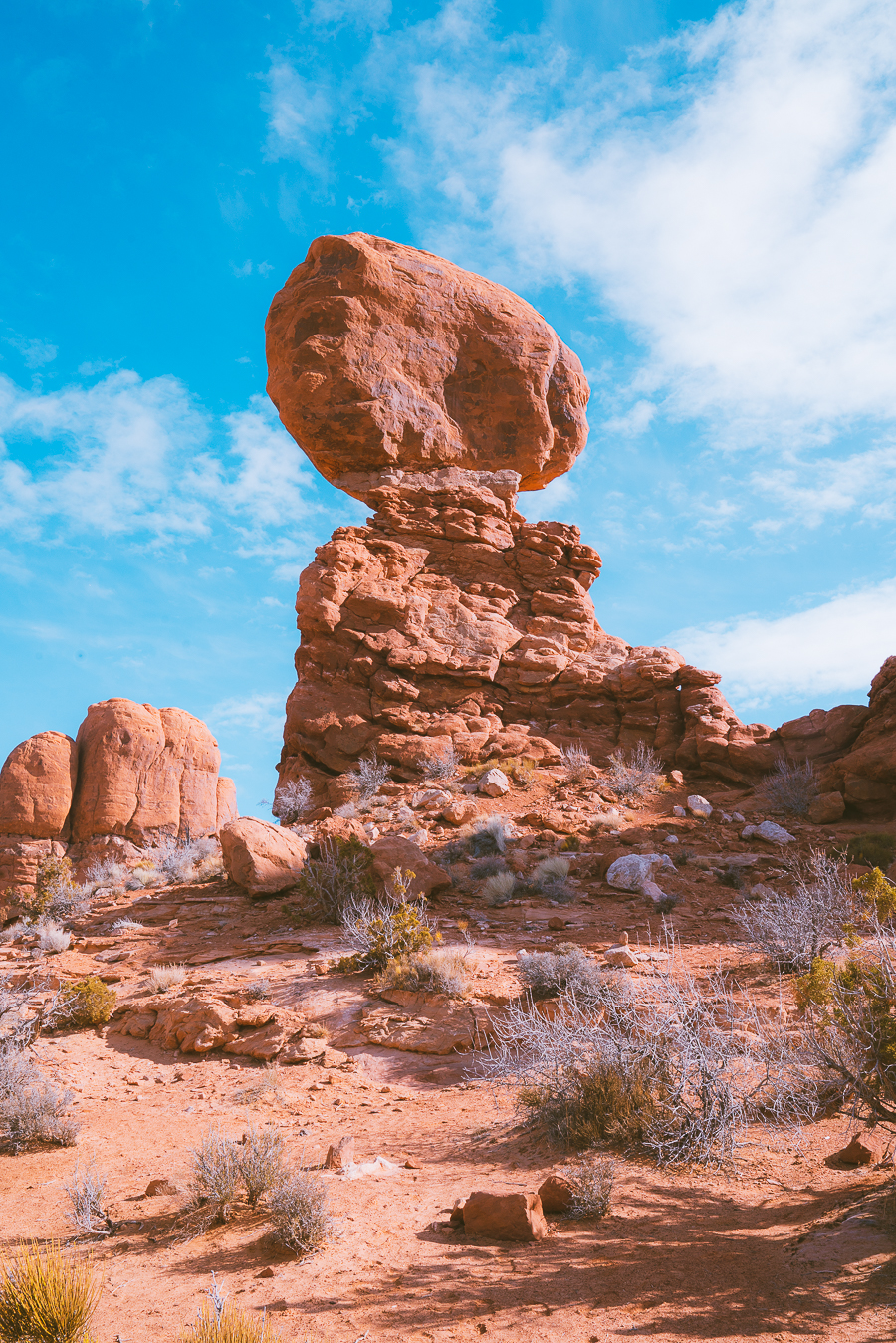
Balanced Rock is a cool and quirky rock formation and one of the first sights along the Arches Scenic Road. Here, a large, oval-shaped rock appears to be on the verge of toppling off the rock pedestal holding it up.
You can reach Balanced Rock on a short, 0.3-mile round-trip walk that starts at the parking lot and winds around the rock.
Grab Your Free Car Camping Checklist! 🚗🌲
Ready to elevate your car camping game? Snag our essential checklist to ensure you’ve got everything you need for a stress-free, fun-filled adventure! Perfect for beginners and seasoned campers alike. Download now and hit the road prepared! 🌟🎒
Arches National Park in Winter | FAQs
Still, have some burning questions about visiting Arches in winter? Below are some of the frequently asked questions about a winter visit to Arches National Park.
Is Arches National Park Open in Winter?
Arches National Park is open during winter — in fact, it is open year-round. However, the Visitor Center’s operating hours are limited to 9 am – 4 pm, and there are no ranger-led activities during this season.
What Time Does Arches National Park Open During Winter?
Arches National Park is open 24 hours a day, year-round. However, the Visitor Center has limited operating hours and is closed on 25 December.
Does It Snow in Arches National Park?
It does snow in Arches National Park, but the park rarely sees more than 2/3 inches of snow at its snowiest. Most of the snow falls during December and January.
Is Winter a Good Time to Visit Arches National Park?
Winter is certainly a great time to visit Arches National Park. With fewer crowds, cooler temperatures, and a beautiful dusting of snow resting on the red rock formations, Arches in winter is a dreamy place.
General Tips for Visiting Arches in Winter
Below are a few general tips to help you plan for your trip to Arches in winter.
- Be flexible with your plans: It is possible that you won’t encounter any snow on your visit to Arches. It’s also possible that you might have to skip certain hikes due to excessive snow or ice. So try to have backup plans in case the weather in Arches National Park doesn’t work in your favor.
- Wear layers: The temperatures in Arches National Park can change without warning. Try to wear many light layers of clothing so you can put on and take off items as the weather changes.
- Wear waterproof clothing and shoes: The last thing you want is soaked shoes or pants due to the snow.
- Leave no trace: The ecosystems and geology of this park are extremely sensitive. Stay on marked trails, don’t climb on rock formations, and remember the principles of leaving no trace.
- Buy A National Park Pass: If you are an avid hiker like me, it’s worth getting the year-long America The Beautiful Pass. >Get It Here
- Bring An Arches National Park map in case you get lost while hiking. >Get One Here
Arches Winter Photography Tips
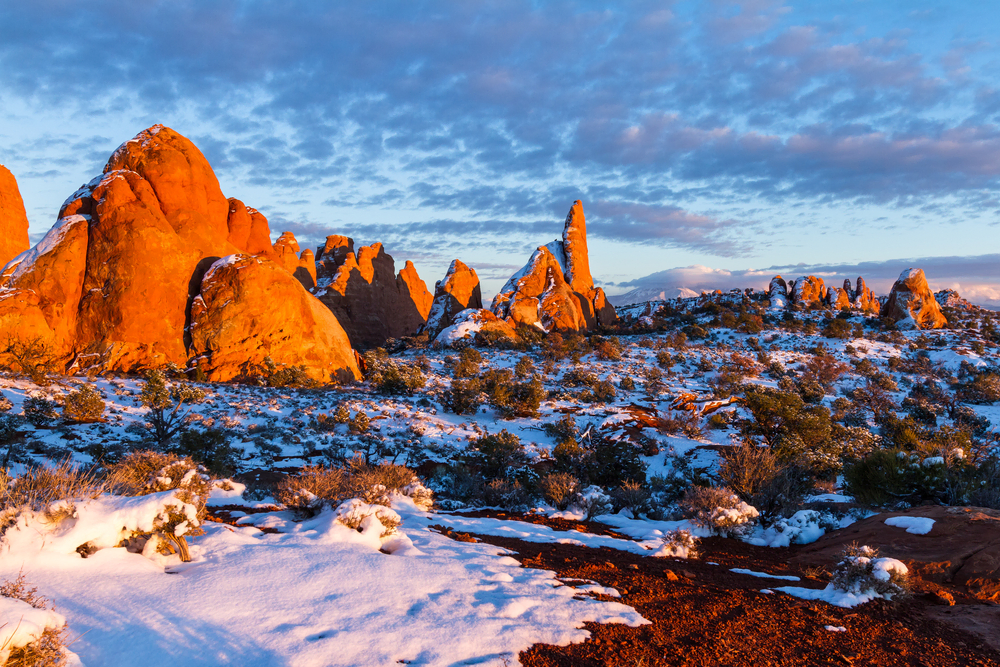
Arches National Park is heavenly to photograph during winter. Much like with Bryce Canyon in winter, the unique contrast between the red sandstone and white snow makes for unbeatable photographs.
Some of the best places to capture the arches doused in the morning light are The Three Gossips, Double Arch, and Landscape Arch. In contrast, the Fiery Furnace Overlook, The Windows, and Delicate Arch are beautifully lit in the late afternoon.
Delicate Arch draws quite a few amateur and professional photographers around sunset — yes, even during winter — so try to arrive early.
Be sure to keep your hands warm and pack a good headlamp for early morning or late night hikes to and from your sunrise or sunset viewpoints.

Note: You’re not always going to encounter snow on your visit to Arches National Park in winter. Often, the snow will melt within 2-3 days or even within a few hours. But your best chance of photographing snowy arches is during December or January.
Tips on the Winter Road Conditions in Arches National Park
The main road running through the park, Arches Scenic Road, is open year-round. Occasionally, the road will be temporarily closed for snow removal. The Visitor Center will be your best point of reference when arriving at the park, as the staff will be able to provide the most recent updates about road and trail closures.
Although Arches National Park doesn’t receive tons of snowfall, the roads can still be icy and slippery. Ensure that your vehicle and tires are road-worthy and able to traverse snow-covered or icy roads.

Tip: Visit the National Park Service’s official page for Arches NP for contact information and updates on weather conditions, closures, and events.
Tours At Arches National Park
Ready for Your Arches Winter Adventure?
Hopefully, this guide has equipped you with everything you need to know about visiting the stunning Arches National Park in winter. With adequate preparation — and enough warm clothing layers — your trip to Arches will be absolutely memorable. And, with lower accommodation prices and less traffic on the trails, your winter visit will be extra convenient.
Now all you have to do is refresh your hiking photography knowledge and pack. If you’re looking for more winter adventure, why not have a look at this Arches to Canyonlands itinerary for inspiration?

